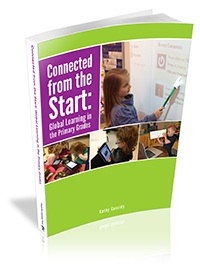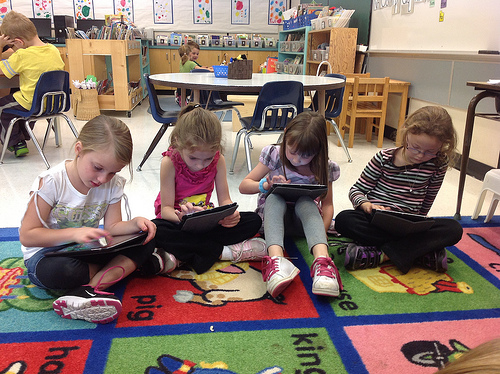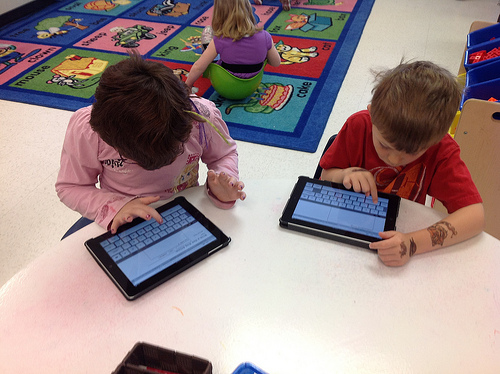 Editor’s note: Kathy Cassidy is the author of a new book from Powerful Learning Press, Connected from the Start: Global Learning in the Primary Grades. During a recent webinar (free archive here), Kathy shared many ideas from Chapter 5 of the book, “Using Blogs as Digital Portfolios.” The webinar was rich in content and full of great discussion — so much so that there simply wasn’t time for Kathy to share her thoughts, in depth, about where formative and summative assessments might fit into this digital blog/portfolio model.
Editor’s note: Kathy Cassidy is the author of a new book from Powerful Learning Press, Connected from the Start: Global Learning in the Primary Grades. During a recent webinar (free archive here), Kathy shared many ideas from Chapter 5 of the book, “Using Blogs as Digital Portfolios.” The webinar was rich in content and full of great discussion — so much so that there simply wasn’t time for Kathy to share her thoughts, in depth, about where formative and summative assessments might fit into this digital blog/portfolio model.
So we’ve asked her to write this article. Much as she does in her eBook, she’s included short videos, useful downloads, and links to other valuable resources. ~ John Norton
A Great Tool to Continuously Assess Progress
by Kathy Cassidy
In my classroom, each of my grade one and grade two students has their own blog. These blogs also serve as digital portfolios. Throughout the school year, the children post artifacts of their learning from all subject areas, including writing samples, podcasts of reading fluency, photos of artwork, explanations of mathematics concepts and videos that summarize their learning in science, health and social studies. (Note: The videos linked to in this blog post work best when played through Google Chrome.)
The children have these online portfolios for many reasons, including an authentic audience, parental engagement, and the opportunity to create an online community. We also use these digital portfolios for assessment, but not in the “this goes on the report card” sense that you might expect.

Formative Assessment
I am continually doing formative assessment in my classroom — that is, assessment for learning. As I watch the students, listen to their questions and answers and see the learning artifacts they produce, I am constantly gauging their understanding of a concept and their readiness to move on to the next one. Experienced teachers do a lot of this kind of immediate, ongoing assessment without much conscious thought.
This continuous formative assessment is one of the primary purposes of our digital portfolios in my mind. The artifacts on my students’ digital portfolios inform my teaching and help me to meet the particular needs of each of my learners. The chronological nature of blog posts lets my students, their parents and me see where the children began and where they are at present. We can think together about where we want to go next.
In fact, we use what is posted on the student’s blog as the starting points for our discussions at our student-led conferences where we look (with parents) at what they have posted and set goals for the next term.
Verbal explanations
I have always used formative assessment in my classroom, but our digital portfolios give me much richer information than our paper portfolios ever did. Because my young students are still beginning writers, it is often difficult for them to explain their learning through writing. They can, however, explain their learning verbally. There are lots of apps (including my current iPad favorites Educreations and Draw & Tell) that record voice over an image. These digital artifacts allow me to understand a child’s thinking in a much deeper way.
For example, I recently asked my grade two students to record their thinking while solving a two-digit math equation that involved “borrowing.” They were all able to demonstrate for me that they could do the process involved in solving this kind of equation. If I had been using paper for this that would have been the end of my understanding. Because the students had recorded their thinking at the same time using a screen-casting app, I could tell that although they could all do the mechanics of the problem, most of them could not enunciate that they were actually borrowing a ten. Clearly more learning needed to be done. If I had been using paper portfolios, I would not have realized this.
When my grade one students explained the addition strategies that they knew using a screen-casting app, I had only to watch their videos to realize which students needed further instruction for which strategies.
Self-assessment is part of our formative assessment process. Self-reflection is important to any learner, whether old or young. While I ask my students to self-assess frequently, I have only recently begun asking them to include this as part of their portfolio. I intend to make this a more regular habit.

Summative Assessment
There are some occasions when I think a student’s digital portfolio can be used for summative assessment or assessment of learning.
For example, at the end of units of learning in science, social studies or health, I ask my students to create a project that shows what they have learned about that particular topic. We talk about digital and paper choices they could make for sharing what they know (despite our 1-to-1 iPad environment, markers and poster board are still extremely popular). Then we make an anchor chart about what they should include in their project.
One of the criteria for these end-of-unit summaries is that they must be put into a digital form that can be posted on their blog. Making a video that shows the artifact they have created along with a verbal explanation of the necessary information is the most popular way to do this. Once the students have completed the assignment, I have a rich record of their learning. I use these projects as summative assessment.
The important thing that makes this assessment summative is that the students know, before they start, that this is going to be used as a final assessment. They also know what needs to be included and the criteria that I will be using when I judge it.
Sometimes No Assessment is Necessary
A few of the items that my students post to their portfolio are for neither formative nor summative assessment.
 These are posts that are selected by the students themselves to show the things that they have chosen to learn on their own – either during an indoor recess (we get more than our share of these during the winters in Saskatchewan), at home, or after they have completed a project at school. These posts include drawings of SpongeBob SquarePants, pictures of Lego creations or videos of dominos falling.
These are posts that are selected by the students themselves to show the things that they have chosen to learn on their own – either during an indoor recess (we get more than our share of these during the winters in Saskatchewan), at home, or after they have completed a project at school. These posts include drawings of SpongeBob SquarePants, pictures of Lego creations or videos of dominos falling.
While these creations have nothing to do with our curriculum, they are important to the child and thus important to include as part of their digital portfolio.
The beauty of digital portfolios is that as the children and I are constantly assessing their learning in a formative and summative way, the students are also demonstrating their growing knowledge for a wide audience and learning about digital citizenship and appropriate online behavior. What great by-products of the assessment process!
Kathy Cassidy
Latest posts by Kathy Cassidy (see all)
- Technology in the Classroom: Embrace the Bumpy Ride! - March 21, 2019
- Passion Based Learning (PBL) in Primary: Making Up the Rules - March 13, 2019
- Passion Based Learning (PBL) in the Primary Grades: Who Asks the Questions? - February 17, 2019


Kathy:
Will share this with parents and colleagues. Thanks so much for laying the assessment rationale out so clearly. Many thanks for Skyping into our #techplc a couple weeks ago. You really inspired people to actively look at blogging with their primary classes.
Have read/heard some interesting pushback from intermediate educators (like @heidisiwak) on whether digital portfolios continue to be a good idea as students get older. If a Grade 7 writes a strong anti-fracking blog in Grade 7, and wants a job in the oil patch in his/her 20’s, would that count against him/her. Interesting discussions going on.
That is interesting, Lisa. I don’t pretend to know anything about teaching middle years, but it certainly is something to think about!
I wonder, Lisa, if we are trying to solve a problem that we do not really have. Middle school, high school, and even college are learning opportunities. If we are committed to lifelong learning, are we really going to assume that an opinion printed in a blog when I was 13 is the way I think now? Do I not get credit for the learning I experience and embrace between 13 and 20-something…50-somethting for that matter?
Kathy,
Two questions–1) Which Blog site do you use, and 2) How do you have the “permissions” set for viewers of the Blog?
–Eric
Two good questions, Eric.
I use Edublogs. http://mscassidysclass.edublogs.org/
Anyone can view and comment on any of the blogs of my students, but all comments are moderated.
Hi Kathy-great article. Your example of learners being able to do the work, but who were not able to articulate their answers verbally really stands out for me–an excellent reminder of how important it is to listen to our students and give them opportunities to explain/ justify their understanding…the process rather than the product. Using tech in this way gives us a whole new scope for being an observer and listener in the classroom. Thanks for the insight!
The grade one blog looks awesome, my question is that does kids need any help when they make posts on the blog? If so, I imagine from the adults at school or at home, do you think it is a good way to engage the community or you hear a something different from the parents?
Minhua, at the beginning of the year, the students do need lots of support, but as the year progresses, they become very independent.
Blogs that are digital portfolios of students’ work is definitely a good way to engage the parents and indeed the entire world in what my students are doing! The parents of my students tell me that they appreciate being able to see their child’s progress on the blog.
Can you post a picture of your anchor chart? I use them a lot in my classroom and I would love to see what yours looks like.
Blogs are powerful learning tools for the student,parents and teacher. Blogs allows the shy or reluctant student a means to share their thoughts. Every student regardless of grade level is able to use blogs to think, reflect on what they are being asked before sharing
Digital portfolios are perfect for showing improvement overtime. Teachers,students and parent are able to see the students strength and weakness. Now that I have been introduced to digital portfolios it is my goal to use it with my students.
Thank you for sharing. This has given me several wonderful ideas to use with my 5th grade students next school year. We will be starting a blog page from Guam.